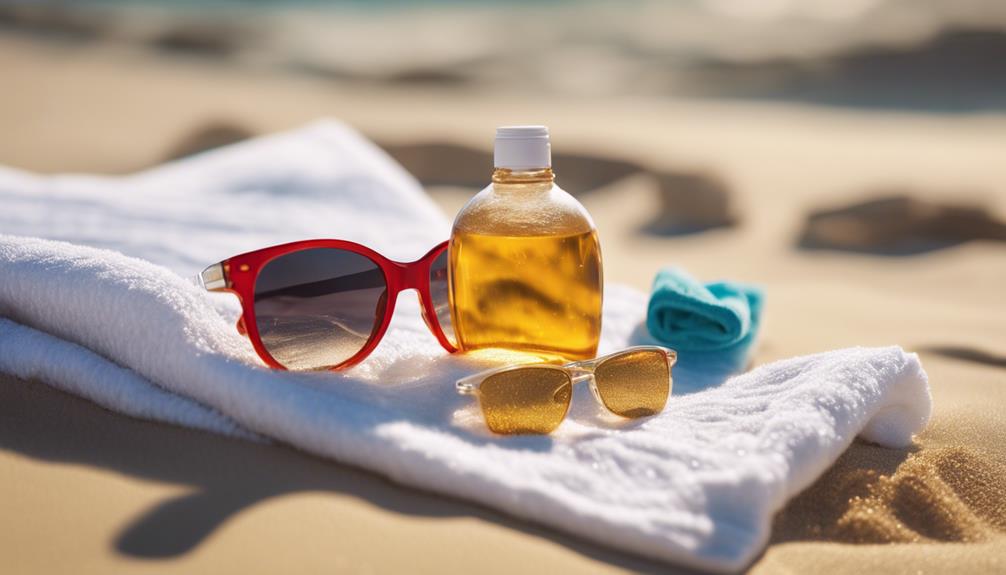When choosing between stand-up and lay-down tanners, you'll find distinct pros for each. Stand-up beds offer quick sessions, providing even bronzing with 360-degree UV coverage, ideal for those who want faster results. In contrast, lay-down beds create a relaxing atmosphere, perfect for unwinding while applying tanning products; they're also better for sensitive skin. Consider your comfort, time, and tanning goals when making your decision. Each option has its unique experience, so think about what fits your needs. Discover more insights that could help you make the best choice for your tanning journey.
Key Takeaways
- Stand-up tanning beds provide quicker sessions with 360-degree UV coverage for an even tan without repositioning.
- Lay-down tanning beds offer a relaxing experience, ideal for those with mobility challenges or seeking stress relief.
- Stand-up beds feature stronger bulbs, leading to faster bronzing results compared to lay-down options.
- Lay-down beds allow for comfortable application of tanning products while promoting overall relaxation during sessions.
Overview of Tanning Bed Types
When choosing between stand-up and lay-down tanning beds, you'll find each offers unique benefits tailored to your tanning preferences.
Stand-up tanning beds provide quick, even bronzing without pressure points, making them perfect if you're in a hurry. You can enjoy a 360-degree exposure while standing, allowing for multitasking during your session.
On the other hand, lay-down tanning beds create a relaxing environment, ideal for unwinding. They offer a gentler UV exposure, catering to those with sensitive skin or mobility challenges.
Both options cater to different tanning needs, whether you're after an efficient tan or a soothing experience. Your choice ultimately depends on your comfort and tanning goals, so consider what suits you best.
Benefits of Stand-Up Tanning
Stand-up tanning offers several advantages, including quick and efficient sessions that maximize UV exposure without the discomfort of pressure points.
You'll enjoy 360-degree UV coverage, ensuring an even tan without those annoying white spots. Since you won't have to twist or reposition yourself, you can achieve consistent results in less time. This is perfect for your busy lifestyle, allowing you to fit tanning into your schedule easily.
With stronger bulbs often found in stand-up booths, you can experience faster bronzing, making your visits even more effective. Plus, the freedom to move around means you can easily adjust your position for ideal exposure.
Advantages of Lay-Down Tanning

Lay-down tanning provides a comfortable and relaxing experience, making it perfect for those looking to unwind while achieving their desired glow. You can simply lie back and enjoy the gentle warmth of the UV rays without the stress of standing.
This option is particularly ideal for individuals with mobility challenges, as it's easy to use and requires minimal effort. The gentle UV exposure also minimizes the risk of skin irritation, making it suitable for sensitive skin types.
Plus, you can apply tanning products conveniently while lying down, enhancing your tanning results. The tranquil environment promotes stress relief, providing a mini-escape from daily life.
Key Differences in Experience
Choosing between a stand-up and lay-down tanning bed considerably influences your overall tanning experience and comfort level.
With stand-up beds, you enjoy 360-degree UV exposure, ensuring an even tan without pressure points. This option is quicker, making it ideal for those with busy schedules. You can move freely, reducing the risk of uneven patches.
On the other hand, lay-down tanning beds provide a more relaxed atmosphere, perfect for unwinding. They allow you to apply tanning products comfortably while lying down. However, the sessions might take longer, and the UV exposure is generally gentler, making it suitable for sensitive skin.
Ultimately, your choice shapes not just your tan but also your overall relaxation and enjoyment during the session.
Factors to Consider When Choosing

When deciding on a tanning bed, consider your personal preferences for comfort, speed, and the type of results you want to achieve.
Think about how much time you have; stand-up beds are great for quick sessions, while lay-down beds offer a more leisurely experience.
If comfort is your priority, lay-down beds provide a relaxing atmosphere, especially if you're looking to unwind.
Additionally, consider your skin type and how it responds to UV rays. If you have sensitive skin, a lay-down bed's gentler exposure might be better.
Finally, evaluate whether you prefer an even tan or a faster bronzing solution.
Making these considerations will help you choose the tanning bed that best fits your lifestyle and goals.
Personal Preferences in Tanning
Your personal preferences play a crucial role in determining which tanning bed type suits you best.
Think about what you want to achieve during your tanning sessions. Here are some factors to reflect on:
- Comfort: Do you prefer lying down or standing up while tanning?
- Time: Are you looking for a quick session, or do you have more time to relax?
- Skin Sensitivity: Do you have sensitive skin that requires gentler UV exposure?
Additional Resources and Information

Exploring various resources can enhance your tanning experience and help you make informed decisions about which tanning bed type is best for you.
Check out articles like '4 Key Tips for Safer Tanning Bed Sessions' and 'Why Choose Stand-Up Over Lay-Down Tanning Beds' for valuable insights. These guides offer safety tips and detailed comparisons to aid your choice.
Additionally, consider reading 'Think Tanning Beds Are Safe? Read Our Guide' for a deeper understanding of the risks involved.
Don't forget to explore recommendations for tanning products, such as '10 Best Tanning Bed Goggles for Ultimate Eye Protection in 2024.'
Consulting with spa professionals can also provide tailored advice for your specific needs.
What are the Pros and Cons of Lay-Down Tanning Beds Compared to Stand-Up Tanning Beds?
When considering tanning bed options, it’s important to weigh the pros and cons of lay-down tanning beds compared to stand-up tanning beds. Lay-down beds offer a more relaxed tanning experience, while stand-up beds provide a quicker session. However, tanning bed risks revealed highlight potential health concerns with both options.
Conclusion
In the end, whether you prefer the quick, confident coverage of stand-up tanning or the soothing, serene escape of lay-down tanning, it's all about what fits your fancy.
Each option offers its own set of splendid benefits that cater to your unique needs.
So, step into the sun-kissed sanctuary that suits you best, and savor the sensational experience of achieving that perfect bronzed glow!
Happy tanning!










